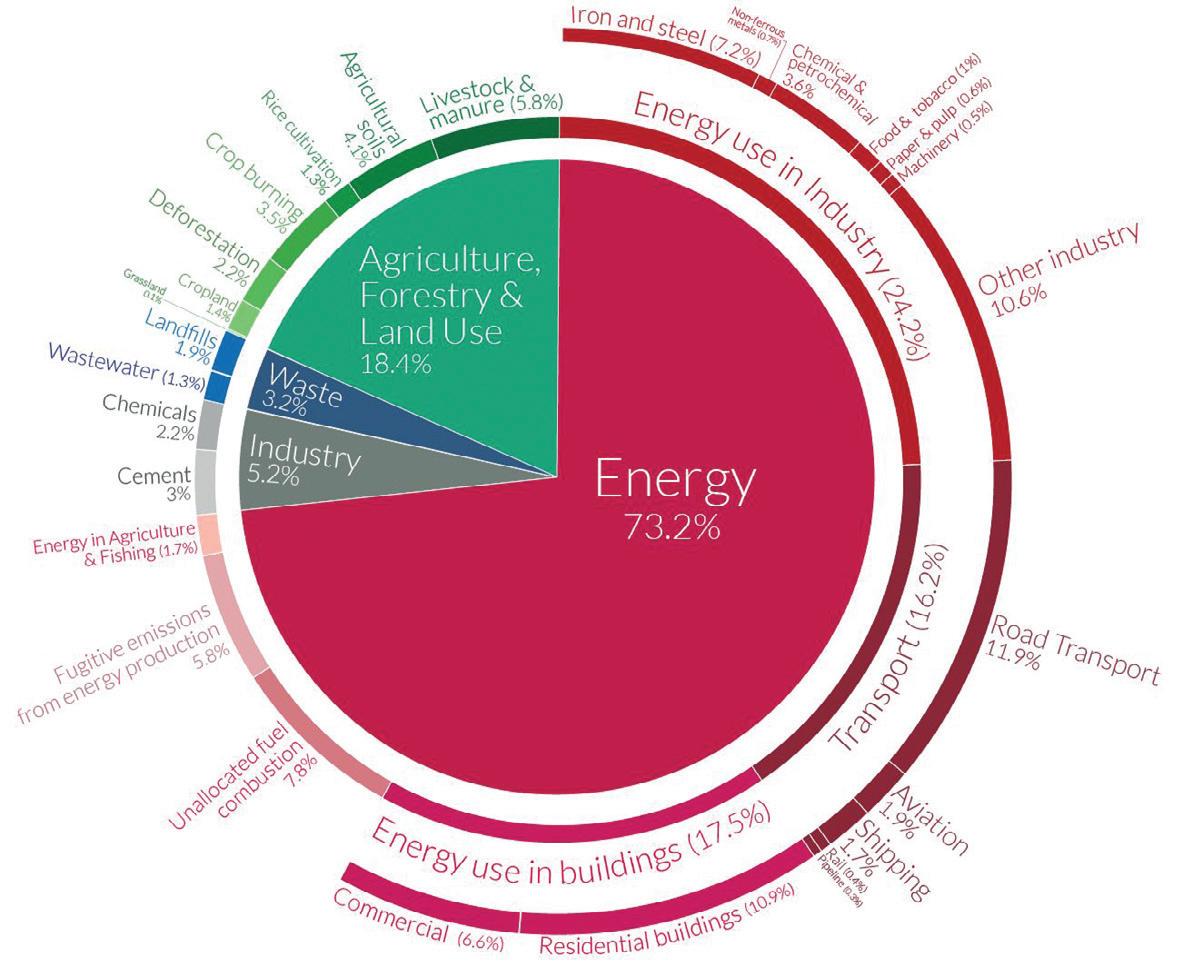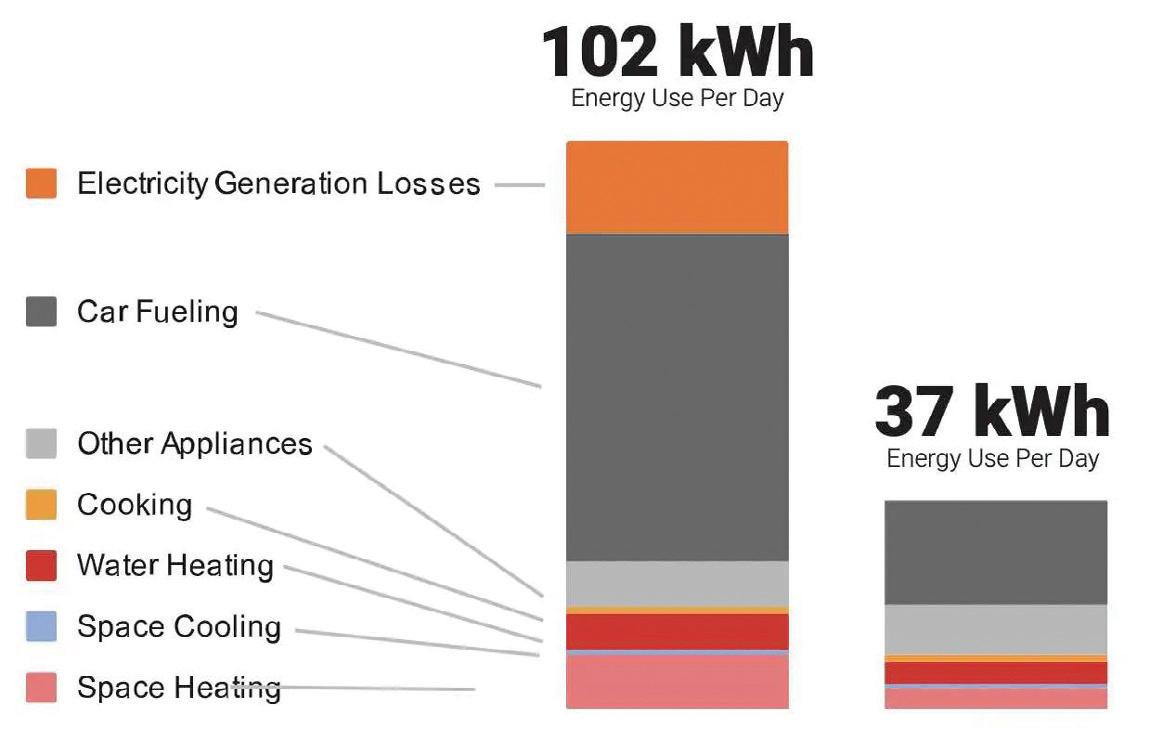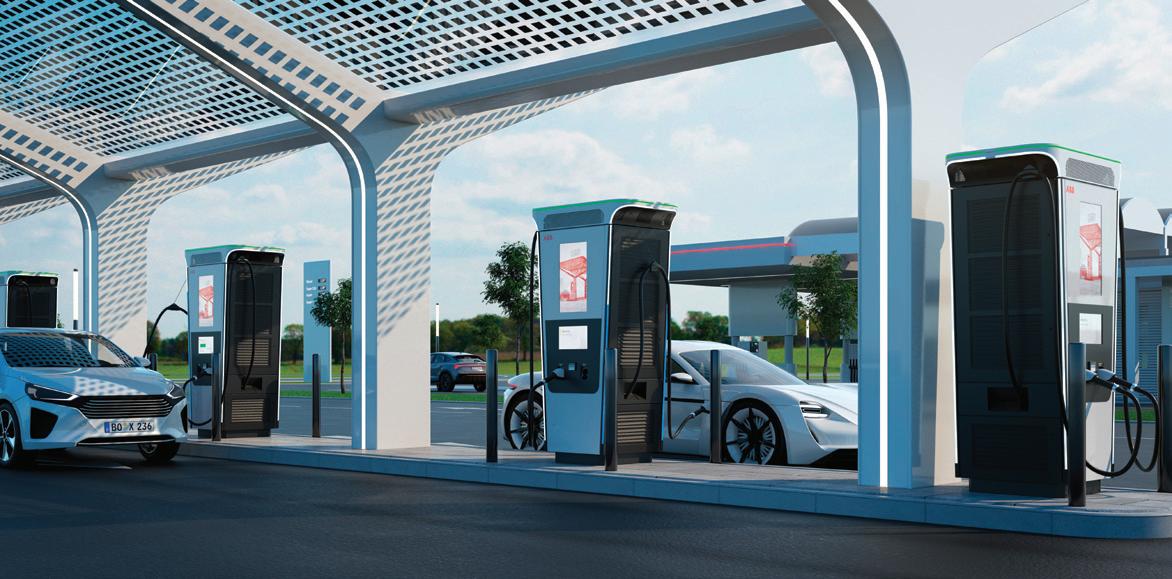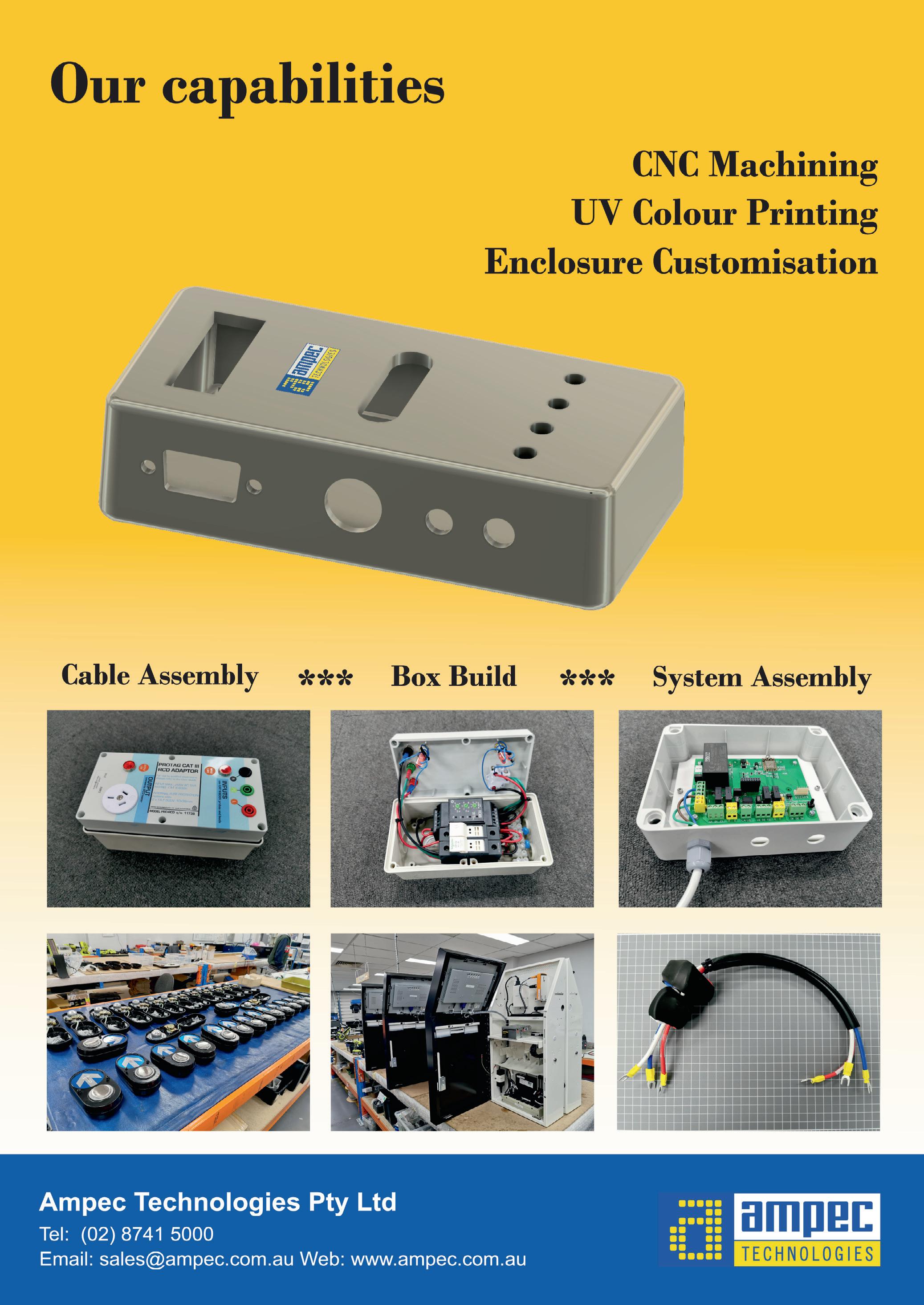
11 minute read
Plug it in: the electrification of everything
PLUG IT IN:
THE ELECTRIFICATION OF EVERYTHING
Glenn Johnson, Editor, Process Technology
There is no doubt that there will be challenges in achieving net zero GHG emissions, but a significant proportion of the task is possible with technologies available today.
The COP26 Climate Conference in Glasgow has loomed large in the news of late. Leaving Australian climate politics aside, on a global scale there have been some initiatives, summarised in a final statement from the conference:
“We have seen a huge shift in coal, with many more countries committing to phase out unabated coal power and ending international coal financing.…While on the world’s roads, the transition to zero emissions vehicles is gathering pace, with some of the largest car manufacturers working together to make all new car sales zero emission by 2040 and by 2035 in leading markets. Countries and cities are following suit with ambitious petrol and diesel car phase-out dates.”1
According to Oxford University’s OurWorldinData.org (Figure 1), energy consumption accounted for 73.2% of GHG emissions in 2016, some significant elements being: • Energy use in industry 24.2% (iron and steel 7.2%, other industries total: 17.2%) • Energy use in transport 16.2% (road transport 11.9%) • Energy use in buildings 17.5% (residential: 10.9%) • The chemical and cement industries also accounted for a further 5.2 % through nonenergy GHG emissions, while agriculture, forestry and land use accounted for 18.4% (livestock: 5.8%).
It is clear from these figures that the largest overall impact on GHG emissions will come from eliminating or reducing energy-related emissions in industry, transport and buildings.
At present there are really only two technologies that allow for energy consumption with zero carbon emissions: electricity from renewable sources and green hydrogen (which also depends on renewable electricity). As a result, there is a growing ‘electrification of everything’ movement.
Changes to the world’s energy mix
According to McKinsey and Company, renewables could produce more than half of the world’s electricity by 2035, at lower prices than fossil-fuel generation.2 The resulting lowering of electricity prices, along with the falling cost of electric equipment and more stringent greenhouse gas (GHG) emission regulation, is expected to boost consumption of electricity in sectors, such as passenger vehicles and space heating, where fossil fuels have long been the standard energy source.

Figure 1: Global greenhouse gas emissions by sector 2016. (Source: OurWorldinData.org).
The industrial electrification landscape
As seen in Figure 1, industry consumes more energy than any other sector, but only about 20% of the energy consumed is electricity. Most of the electricity that is used is to drive machines that move things and materials, such as pumps, robotic arms and conveyor belts. The remaining energy consumption is usually in the form of fossil-fuel energy.
Carbon-based materials are also used as feedstock, such as oil products from which plastics are produced and coking coal that is used to combine carbon with iron to produce steel — in other words, coal and oil are also used as an ingredient, rather than an energy source. In this sense, both coal and (to a lesser extent) oil will always have a place as a carbon source for the foreseeable future, but will be phased out as a source of energy.
Replacing — by electrification — the fuel that industrial companies use for energy has several benefits. Generally, electrically driven equipment is only slightly more energy efficient than the conventional option, but it has lower maintenance costs, and, in the case of (for example) an industrial boiler, the investment cost of the electrical equipment is lower. If zero-carbon renewable electricity is consumed, the greenhouse-gas emissions of the industrial site lower significantly.
McKinsey has estimated that of all the fuel that industrial companies use for energy, almost 50% could be replaced with electricity using technologies available today, including all processes that need to generate heat up to 1000°C. About 30% of fuel consumption for energy is for processes that require very high temperatures, which include the production of steel, cement and ceramics. This will change, however. Only recently, Australian company Calix filed a patent for technology for the production of iron and steel with zero CO2 emissions.3 The company’s technology can produce iron from iron ore in a hydrogen atmosphere between 600°C and 800°C — around 1000°C less compared to a conventional blast furnace. While the technology uses hydrogen in the kiln, the entire process can be renewably powered.
Calix says that while the use of hydrogen in blast furnaces is being tested, there will be limits on the amount of coal it could replace due to a reduction in the conversion rate of iron ore to iron.
Mining is on an electrification binge
One industry that is a large consumer of energy is the mining industry, but over the last six months there have been numerous announcements by our major mining entities and industrial automation companies about mine electrification, particularly in the area of large haul trucks and underground mining vehicles.
BHP and Caterpillar have announced they are working to develop zero-emissions mining trucks, in order to support BHP’s long-term goal of achieving net zero operational GHG emissions by 2050. Similarly, Komatsu has announced same and is working with Rio Tinto on a pilot of electric mine vehicles.4,5
In the underground mining equipment market, Hunter Region-based PPK Mining Equipment is developing battery-electric underground personnel vehicles with the aid of Ampcontrol, and retrofitting diesel drivetrains with BEV technology in other vehicles.
Of course you can’t have large powerful haul trucks without large powerful batteries and the infrastructure to charge them efficiently. To that end, large automation and electrical companies are working on a solution. ABB for one has already announced high-powered fast charge technology to support large electric mining equipment, and compatible with all makes of haul trucks.6

The Rewire Australia movement
“Electrify everything” is also a motto being promoted here and in the US by Australian inventor and US government advisor Saul Griffith. Along with The Australia Institute, Griffith has published a discussion paper called Castles and Cars, which outlines how much Australian households could save if they electrified everything, including the cars, their household heating, their water heating and their cooking.7
According to the discussion paper, the average Australian household currently uses around 102 kWh of energy per day, spends $5248 per year on energy-related costs and releases 11 tonnes of CO2-e into the atmosphere. Much of this energy use is due to the inefficiency of conventional fuels like natural gas and petrol for cars. The report claims that (along with solar panels on the roof and battery storage) changing to new electrical appliances and vehicles would drop the average daily household consumption to around 37 kWh — a nearly 64% net saving — while at the same time largely eliminating the household CO2 emissions. The main reasons for this are: • Electric vehicles charged by renewable energy sources consume only 25–35% of energy of an internal combustion engine-based vehicle (which are about 30% efficient). • Water heaters or space heaters burning natural gas use about three times more energy than an electric heat pump. Heat pump technology as used in refrigerators and air conditioners typically needs only 1 unit of electricity to make 3-4 units of heat.
Additionally, electricity produced using fossil fuel power plants is also highly inefficient, with most coal plants only 25–30% efficient and gas plants around 40–45%. Renewable sources do not have the same thermal losses and toxic waste by-products — and of course no CO2 emissions.
As with all major changes there are challenges with this course of action: problems caused by the change in the balance of energy generation in the power grid (through the addition of so many small generation sources) are proving to be a significant obstacle at the moment. But this is not a challenge that cannot be overcome with engineering know-how and the right investment.
In any case, making homes more energyefficient will ultimately reduce the residential burden on the grid to the point where political debates over residential energy costs, fossilfuel power generation versus renewables, and so-called ‘base-load’ power become redundant.
The problem with the Rewire Australia concept is that most households cannot afford to replace everything that is fossil fuel-based, as well as buy solar panels, battery storage and electric cars at today’s prices. Griffith therefore favours rebates and financing to make it more affordable. He says this needs to be a national priority, in the same way we built the Snowy Mountains hydroelectric scheme or spent money on the COVID-19 response.
“If we begin electrifying our homes with roughly 3% in 2022, 15% in 2024 and 40% in 2026, the spending required to pay for the capital cost difference (or break-even point) is predicted to be around $12 billion in total,” according to the report, with the cumulative savings to be more than $300 billion by 2035.
“For context, that’s just roughly 9% of what we are predicted to have spent on the COVID-19 response in the last two financial years, or roughly 18% of our defence spending in those two years.”
Conclusion
There is no doubt that there will be challenges in achieving net zero GHG emissions, but a significant proportion of the task is possible — not with some as-yet undiscovered future technology, but with technologies available today, by electrifying as much as we possibly can. References 1. UN Climate Change Conference 2021,
COP26 keeps 5C Alive and Finalises
Paris Agreement, <<https://ukcop26.org/ cop26-keeps-1-5c-alive-and-finalisesparis-agreement/>> 2. McKinsey & Company 2019, Peak energy, peak oil, and the rise of renewables:
An executive’s guide to the global energy system, <<https://www.mckinsey. com/industries/oil-and-gas/our-insights/ peak-energy-peak-oil-and-the-rise-ofrenewables-an-executives-guide-to-theglobal-energy-system>> 3. ProcessOnline 2021, Calix files a patent for zero emissions iron and steel, <<https://www.processonline.com.au/ content/business/news/calix-files-apatent-for-zero-emissions-iron-andsteel-398345840>> 4. ProcessOnline 2021, BHP and Caterpillar to develop zero-emissions mining trucks, <<https://www.processonline.com.au/ content/business/news/bhp-and-caterpillar-to-develop-zero-emissions-miningtrucks-431215927>> 5. Rio Tinto 2021, Rio Tinto and Komatsu partnering for zero-emission mining, <<https:// www.riotinto.com/news/releases/2021/
Rio-Tinto-and-Komatsu-partnering-forzero-emission-mining>> 6. ABB 2021, ABB unveils game-changing
ABB Ability eMine to fast-track transition to all-electric mines, <<https://new.abb.com/ news/detail/82055/abb-unveils-gamechanging-abb-ability-emine-to-fasttrack-transition-to-all-electric-mines>> 7. Rewiring Australia, Castles & Cars: Savings in the Suburbs Through Electrifying
Everything (Discussion Paper),<<https:// global-uploads.webflow.com/612b0b172 765f9c62c1c20c9/615a513770739cc647 7e67f4_Castles%20and%20Cars%20Rewiring%20Australia%20Discussion%20
Paper.pdf>>


ELECTRIC CAR CHARGER
ABB has launched its Terra 360 all-in-one electric vehicle (EV) modular charger that can deliver 100 km of range in less than 3 min. Suitable for refuelling stations, urban charging stations, retail parking and fleet applications, the device can simultaneously charge up to four vehicles with dynamic power distribution.
The charger has a maximum output of 360 kW and is capable of fully charging any electric car in 15 min or less, meeting the needs of a variety of EV users.
Available in Europe from the end of 2021, and in the USA, Latin America and Asia Pacific regions in 2022, the charger is designed to deliver speed and convenience along with comfort, ease of use and a sense of familiarity.
Its lighting system guides the user through the charging process and shows the state of C=charge (SoC) of the EV battery and the residual time before the end of an optimal charge session. It is also wheelchair accessible and features an ergonomic cable management system that helps drivers plug in quickly with minimal effort.
As well as serving the needs of private EV drivers at fuelling stations, convenience stores and retail locations, the chargers can also be installed on an organisation’s commercial premises to charge electric fleet cars, vans and trucks. Because the chargers have a small footprint, they can be installed in small depots or parking lots where space is at a premium.
The chargers are customisable to suit branding requirements and there is also the option to include an integrated 27″ advertisement screen to play video and pictures.
ABB Australia Pty Ltd
www.abbaustralia.com.au


HAZARDOUS AREA PRESSURE SWITCH/GAUGE
The Dwyer Series AT-3000MR/MRS ATEX/IECEx approved Photohelic switch/gauge incorporates a flameproof aluminium enclosure with texture epoxy coating that protects the device for use in hazardous areas commonly found in process or industrial applications.
The switch/gauge is designed for monitoring pressure, vacuum and differential pressure. Solidstate switches allow for switching in high cycle rate applications while extending the life of the sensor. These instruments can be installed in various process or HVAC applications globally because of the numerous pressure ranges and units available.
Well suited for industrial applications, the Series AT-3000MR/MRS also features a standard windowed enclosure cover that allows users the ability to visually verify changes in the process. Easy-to-adjust setpoint indicators are controlled by knobs located on the gauge face, accessible by opening the case after de-energising the instrument.
Dwyer Instruments (Aust) Pty Ltd
www.dwyer-inst.com.au
INDUCTIVE PROXIMITY SENSORS
The Pepperl+Fuchs standard portfolio of inductive cylindrical proximity sensors is said to be characterised by a range of features to make installation and operation easy, safe and convenient. The use of updated end caps for fixed cable versions means that the sensor LED is now visible from all angles. The switch state is easily recognised simply by looking at the sensor, even during operation.
Standardised M12 connectors or fixed cables make installation quick and straightforward. Inductive proximity sensors are the preferred choice for the majority of applications requiring accurate, non-contact detection of metallic objects in machinery or automation equipment.
The standard inductive sensor range features smooth or threaded stainless housings; models with PVC, PUR or silicon cable; outputs in 2-, 3-, 4-wire DC, AC NAMUR and AS-Interface versions; LED status indication; and polarity reversal and short-circuit protection.
Pepperl+Fuchs (Aust) Pty Ltd
www.pepperl-fuchs.com










